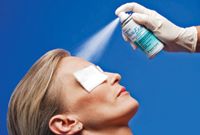- Acne
- Actinic Keratosis
- Aesthetics
- Alopecia
- Atopic Dermatitis
- Buy-and-Bill
- COVID-19
- Case-Based Roundtable
- Chronic Hand Eczema
- Chronic Spontaneous Urticaria
- Drug Watch
- Eczema
- General Dermatology
- Hidradenitis Suppurativa
- Melasma
- NP and PA
- Pediatric Dermatology
- Pigmentary Disorders
- Practice Management
- Precision Medicine and Biologics
- Prurigo Nodularis
- Psoriasis
- Psoriatic Arthritis
- Rare Disease
- Rosacea
- Skin Cancer
- Vitiligo
- Wound Care
Article
Topical anesthetic product proves to ease injection pain
Minimizing pain while performing botulinum toxin injections is of paramount importance to patient and physician alike. Though there are several topical anesthetic techniques from which to choose, Pain Ease (Gebauer Company), a topical anesthetic skin refrigerant, appears to be the best choice, according to an expert.

Key Points

"My impression is that we get better and faster pain relief with Pain Ease compared to simple ice or EMLA (AstraZeneca) cream. Ice and EMLA are notoriously messy, and from a standpoint of tidiness and efficiency, Pain Ease is the superior choice," says James E. Zins, M.D., department of plastic surgery, Cleveland Clinic, Cleveland.
Study details

Each patient served as his or her own control, with either the left or right corrugator muscle receiving the pretreatment refrigerant and the opposite corrugator muscle receiving no pretreatment. All patients received two injections of five units of Botox in each corrugator for a total of 20 units and subsequently reported on pain perception/discomfort levels following the procedure.
Results showed that 13 of 20 patients reported less pain on the treated side, three had less pain on the nontreated side and four reported similar pain on both sides.
Similar to Pain Ease, EMLA cream can also remove the needle-stick pain, but it has a longer time of onset (up to an hour, compared to a few seconds with Pain Ease). What's more, its duration of action is significantly longer (up to five hours) and the cost is higher compared to that of Pain Ease.
According to Dr. Zins, Pain Ease relieves the needle-stick pain but does not necessarily relieve the pain of the injection of material.
Benefits of no pain
"Relieving pain and procedural anxiety is of the most utmost importance for patient satisfaction. Furthermore, removing pain from the equation allows the physician to perform his or her job much more quickly and efficiently," says Richard A. Weiss, M.D., an oculoplastic surgeon and medical director of Weiss Cosmetic & Laser Procedures, Newport Beach, Calif.
Dr. Weiss conducted a study (Weiss RA, Lavin PT. Reduction of pain and anxiety prior to botulinum toxin injections with a new topical anesthetic. Ophthal Plast Reconstr Surg. 2009; 25(3): 173-177) to test whether Pain Ease was more effective in relieving pain upon injection of Botox to the glabellar area, compared to no pretreatment.
In the 52-patient study (26 naive patients who had never had a Botox procedure and 26 patients experienced in the procedure), patients' face sides (left versus right) were randomized to receive either vapocoolant spray or no treatment control. Participants reported on local pain sensation and anxiety experienced before, during and after the procedure.
Results showed that 67 percent of patients reported that the Pain Ease method generated less pain compared to no anesthesia, with 54 percent preferring the Pain Ease method for their next treatment. Pain was a factor in delaying the scheduling of cosmetic Botox treatments in 19 percent of naive patients and 31 percent of experienced patients. Overall, 6 percent of patients reported that they would schedule their next treatment sooner if a vapocoolant such as Pain Ease were available.
Study data also revealed that a considerable percentage of patients either expected pain (35 percent of naive patients expected moderate pain) or had experienced pain from their prior treatment (35 percent had expected moderate pain). In the study, 15 percent of naive patients had moderate or severe anxiety, and 31 percent of experienced patients had moderate anxiety.
Botox injections are primarily used in the upper face. Therefore, it is important to protect the eye from any material that might cause irritation. Dr. Weiss developed a novel vapocoolant "comfort" shield designed to protect the eye from any potential overspray. With use of the shield in Dr. Weiss' study, there was no leakage of spray or eye irritation in any patient. DT
Disclosures: Dr. Weiss' study received unrestricted scientific/education grants from Allergan and Gebauer Company.
Newsletter
Like what you’re reading? Subscribe to Dermatology Times for weekly updates on therapies, innovations, and real-world practice tips.











